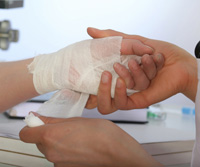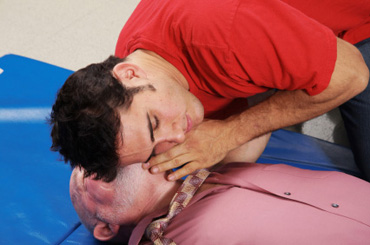
On Site Call:
086 8012925

>
Three day occupational first aid courses
Course Details:
This comprehensive three day Further Education and Training Awards Council (FETAC) Occupational First Aid level 5 certificate course covers all the essential aspects of Occupational First Aid as outlined in Module D2018. This course will provide the learner with the knowledge and practical skills to give effective life support, diagnose & treat injuries or illness, maintain care and comfort of the casualty. This course will also provide the learner with an understanding required to provide and co-ordinate first aid in the workplace in compliance with the requirements of the Safety, Health and Welfare at Work (General Application) Regulations 2007: Part 7 - Chapter 2: First Aid and associated guide to these regulations.
An occupational first aider is a qualified person who is trained by a registered competent instructor in accordance with the standard set by the Health & Safety Authority (H.S.A.) of Ireland and Pre-Hospital Emergency Care Council (P.H.E.C.C.)
With training from our HSA recognised Instructors, our Occupational First Aid courses will satisfy your legal requirements under the regulations.
Under the Safety, Health and Welfare at Work (General Application) Regulations 2007, there is a requirement on employers based on a risk assessment to have a sufficient number of Occupational First Aiders trained and deployed in the workplace. With training from our HSA recognised Instructors our Occupational First Aid courses will satisfy your legal requirements under the regulations. All our teaching staff are registered Occupational First Aid instructors with the Health & Safety Authority agent OFAAA.
This programme is delivered as 3 day course by Certified Occupational First Aid Instructor from the HSA register.
Objectives of Course:
Learners who successfully complete this module D20188 will:- Understand the responsibilities of the occupational first aider
- Be familiar with health and safety legislation on first aid provision in the workplace
- Be able to provide treatment for preserving life or minimising the consequences of injury until the arrival of medical aid
- Be able to provide treatment in the workplace for an injury which does not require the attention of a medical practitioner or nurse
- Be capable of coordinating first aid arrangements in the workplace
- Successful participants will be registered as Occupational First Aiders with FETAC certification.
 Programme :
Programme :
- Unit 1: First aid in the workplace
This module covers the role of the Occupational First Aider, the legal requirements and
how to effectively ensure the safety of the first aider in the workplace.
- Unit 2: Patient assessment
After this module, the candidate will be able to do a primary and secondary survey on a potential casualty. They will know how to take vital (pulse, breathing, etc) signs and treat a casualty with a suspected neck injury. - Unit 3: Respiratory emergencies
This module covers the functions of the respiratory system and shows the Occupational First Aider how to manage a choking patient as well as how to do mouth-to-mouth ventilations.
- Unit 4: Cardiac first response
After this module, the student will understand the chain of survival and will be able to activate their links, by calling for an ambulance, starting CPR and using a Defibrillator effectively.
- Unit 5: Wounds and bleeding
This module teaches the student how to deal with blood injuries. They will know how to recognise the different types of wounds and know how to treat them. They will be able to deal with head, eye and facial injuries as well as effectively minimising the consequences of internal bleeding.
- Unit 6: Altered levels of consciousness
The student learns how to treat shock and how to do the recovery position.
This will allow them to treat a casualty who has reduced or lost consciousness.
- Unit 7: Musculoskeletal injuries
At the end of this module, the student will be able to treat patients who have fractured (broken) bones as well as deal effectively with casualties who have sprains, strains and dislocations.
- Unit 8: Burns and scalds, chemicals, electric shock
This module covers the treatment of major and minor burns as well as the many different causes of burns. It also covers poisoning and how best to treat someone who has been poisoned. The student will cover electrical shock and how to manage a patient who has been electrocuted.
Who Should attend:
Anyone who wants to be trained and certified as an Occupational First Aider and deliver first aid care according to the protocols taught in the course.
Pre-Course Requirements:
No pre course requirements but English is the language in which training is delivered and participants must have a good command of the English language. If participants wish to bring an interpreter this can be arranged with prior notice which must be given to Doyle Health and Safety.
Assessment/Certification:
Participants complete a theoretical exam and practical skills assessments as indicated below. All assessments are carried out in accordance with FETAC regulations. All participants who successfully complete the written and practical examinations will be awarded with a FETAC Level 5 component  certificate in Occupational First Aid which is valid for 2 years as per HSA guidelines.
certificate in Occupational First Aid which is valid for 2 years as per HSA guidelines.
Summary of Assessments:
Basic Life Saving Skills 40%
Examination (Short Answer Questions) 30%
Skills Demonstration x 2 30%
Grading:
• Pass 50-64%
• Merit 65-79%
• Distinction 80-100%
The OFA instructor advises the format of assessment which is conducted
by an independent Instructor recognised by the Health & Safety Authority.
 General:
General:
Please let us know if participants have any specific learner requirements or any form of disability.
Duration:
3 days (24 hours)
Maximum:
Maximum 10 & 8 from Sept. 2010